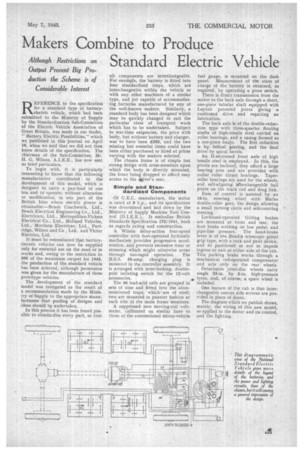Makers Combine to Produce Standard Electric Vehicle
Page 23

If you've noticed an error in this article please click here to report it so we can fix it.
Although Restrictions on Output Prevent Big Production the Scheme is of Considerable Interest
REFERENCE to the specification for a standard type of batteryelectric vehicle, which had been submitted to the Ministry of Supply by the Standardization Sub-Committee of the Electric Vehicle Association of Great Britain, was made in our leader, " Battery Electric Possibilities," which we published in this journal on April 16, when we said that we did not then know details of the specification. The chairman of the Sub-Committee, Mr. 11. G. Wilson, A.I.E.E., has now sent us brief particulars.
To begin with, it is particularly interesting to know that the following manufacturers contributed to the development of this model, which is designed to carry a pay-load of one ton and to operate, without alteration or modification, in any part of the British Isles where electric power is ohtainable:—Brush Coachwork, Ltd., Brush.Electrical Engineering Co., Ltd., Electricars, Ltd., Metropolitan-Vickers Electrical Co., Ltd., Midland Vehicles, 'Ltd., Morrison Elect'ricar, Ltd., Partridge, Wilson and Co , Ltd.. and Victor Electrics, Ltd.
It must be remembered that batteryelectric vehicles can now be supplied only for essential use on the road or in works and, owing to the restriction to 500 of the maximum output for 1943, • the production of the standard vehicle has been deferred, although permission was given for the manufacture of three prototype vehicles. .
The development of the standard model was instigated as the result of a recommendation made by the Ministry of Supply to the appropriate manufacturers that pooling of designs and ideas should bg undertaken. In this process it has been found possible to standardize every part, so that all components are interchangeable. For example, the battery is fitted into four standardized trays, which are interchangeable within the vehicle or with any other machines of a similar type, and yet capable of accommodating batteries manufactured by any of the well-known makers. Similarly, a standard body has been designed which may be quickly changed to suit the particular class of transport work which has to be undertaken. Subject to war-time exigencies, the price with body, but without battery and charger, was to have been 4355, and the two missing but essential items could have been either purchased or hired at prices varying with the makers selected.
The chassis frame is of simple but strong design with cross-members upon which the body is directly mounted, the front being dropped to afford easy access to the iisiver's seat, Simple and Stan dardized Components -Of G.E.C. manufacture, the motor is rated at 8 h.p., and its specification was determined and laid down by the Ministry of Supply Machine Tool Control (D.I.E.E.). It embodiesBritish Standards Specification 173/1941, both • as regards rating and construction.
A Wilson delay-action four-speed controller with foot-operated hydraulic mechanism provides progressive acceleration, and prevents excessive wear or stressing which might otherwise occur through too-rapid operation. The B.S.S. 50-amp. charging plug is mounted in the controller assembly. It is arranged with inter-locking, doublepole isolating switch for the 12-volt accessories. .
The 36 lead-acid cells are grouped in sets of nine and fitted into the aforementioned trays, which are of steel; two are mounted in pannier fashion at each side of the main frame members.
A suppressed zero moving-coil voltmeter, calibrated on similar lines to those of the conventional nrotor-vehicle fuel gauge, is mounted on the dash panel. Measurement of the state of charge of the battery is obtained, as required, by operating a press switch.
There is direct transmission from the motor to the back axle through a short, one-piece tubular shaft equipped with Layrub patented joints giving a cushioned drive and requiring no lubrication.
The back axle is of the double-reduction type with three-quarter floating shafts of high-tensile steel carried on roller bearings, and a casing formed as a one-piece banjo. The first reduction is by helical gearing, and the final drive by spiral bevels.
An H-sectioned front axle of high tensile steel is employed. • In this, the pivots are inclined; they afford a large bearing area and are provided with radial roller thrust bearings. Taperroller bearings are used for the wheels, and self-aligning iEterchangeable ball joints on the track rod and drag link.
Ease of control is 'assisted by an I8-in, steering, wheel with Marles double-roller gear, the design. allowing small turning circle and self-centring steering.
Lockheed-operated G Wing brakes are mounted at front and rear, the foot brake working on low pedaland pipe-line pressure. The hand-brake lever is of the Bendix telescopic pistol grip type, with a rack and pawl device, and so positioned as not to impede ingress or exit at either side of the cab. This parking brake works through a mechanical rod-operated compensator and acts only on the rear wheels.
Detachable ,steel-disc wheels carry single 23-in. by 5-in, high-pressure • tyres, and, of course, a spare wheel is included.
One feature of the cab is that interchangeable canvas side screens are provided in place of doors.
The diagram which we publish shows, mainly, the wiring of this new model, as applied to the motor and its control, and the lighting.




















































